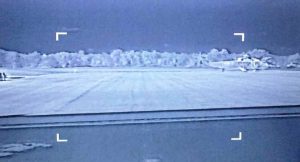 Astronics Corporation, through its wholly owned subsidiary Astronics Max-Viz, is collaborating with the Federal Aviation Administration (FAA) in a research project to study operational concepts for the use of Enhanced Flight Vision Systems (EFVS) in helicopters.
Astronics Corporation, through its wholly owned subsidiary Astronics Max-Viz, is collaborating with the Federal Aviation Administration (FAA) in a research project to study operational concepts for the use of Enhanced Flight Vision Systems (EFVS) in helicopters.
The study is designed to develop a basis for possible application of enhanced vision systems in helicopters flying into heliports. While EFVS rules exist for approaches to runways at airports, comparable regulations for EFVS do not exist for helicopters flying to onshore or offshore helipads at heliports.
“Astronics is very pleased to provide both a Max-Viz 1500 and a Max-Viz 2300 Enhanced Vision System (EVS) to the FAA for integration onto its Sikorsky S-76 medium-size commercial utility helicopter test aircraft for this study,” said Astronics Max-Viz’s Dale Farr, Manager of Sales and Business Development. “The Astronics Max-Viz EVS sensors will be used in flight tests and data acquisition for EVS and EFVS implementation,” he added.
Flight-testing is being conducted by the FAA’s William J. Hughes Technical Center, at the Atlantic City International Airport in New Jersey. The center serves as the national scientific test base for the FAA. Programs include research and development, test and evaluation, and verification and validation in air traffic control, communications, navigation, airports, aircraft safety, and security.
The Max-Viz 1500 sensor will provide baseline testing, which will be followed with the installation of the Max-Viz 2300 for observation of LED lighting on the blended high resolution long wave infrared image. Flights are planned to occur in various weather and visibility conditions, day, night and twilight and via alternative approaches. Results of the study will be used by the FAA to evaluate the effectiveness of EFVS technology for helicopter flight safety and operational effectiveness.
Astronics’ top of the line EVS, the Max-Viz 2300, provides pilots with an unprecedented level of situational awareness and safety by enabling them to see more precisely during day or night in adverse weather conditions, such as haze, smoke, smog and light fog, even in the darkest night. At night, pilots can also see and avoid clouds for a smoother ride. Upon landing, pilots using the Max-Viz 2300 can view the runway and terrain clearly to avoid wildlife and unlit obstructions.
This advanced EVS is a lightweight, affordable, multi-spectral imager that blends the separate signal from a long wave infrared sensor with a visible light sensor to present pilots with a single, sharp, real-time image. The blended thermal image is black and white, but a separate color HD-compatible signal from the visible light camera is available for routing to a cabin entertainment system or cockpit for a complete color display. The Max-Viz 2300 system is certified to Radio Technical Commission for Aeronautics (RTCA) DO-160G standards, which is the industry standard for the environmental testing of avionics hardware and is recognized by the International Organization for Standardization (ISO) as the de facto international standard ISO-7137.


